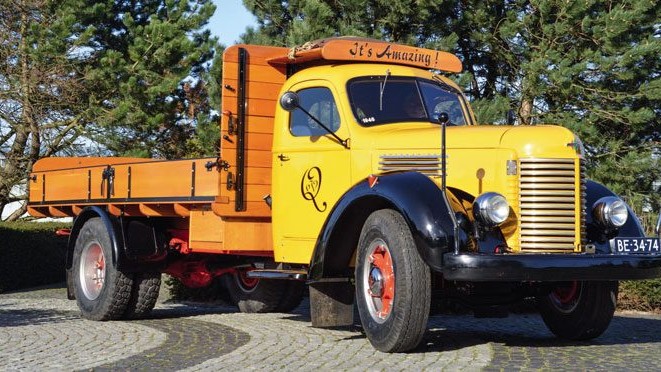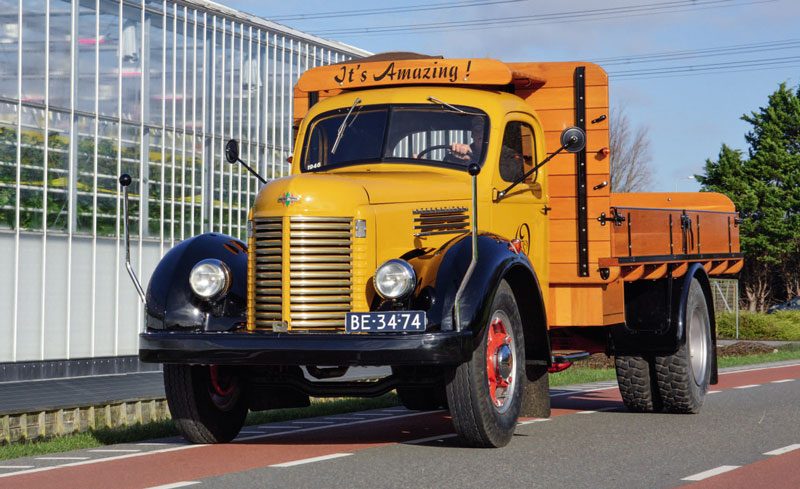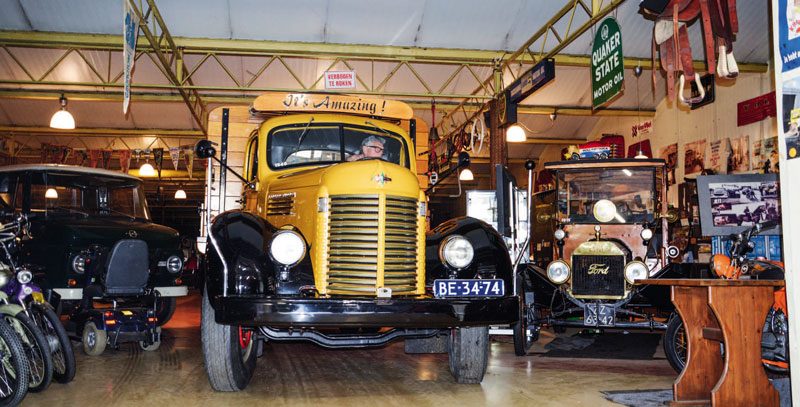
In dark sheds and private museums hide countless vintage cars and trucks that hardly anyone knows about. This story is about one such gem.
Widely known person in the European classic auto world is Quirien van Vliet from The Hague area. The 72-year-old Dutchman has been collecting and refurbishing old vehicles as a hobby for 35 years. Although the emphasis is on classic trucks and luxury cars, he also owns several special tractors and earthmovers. Some of the collection stands there ‘as found’; others have been restored in detail. The latter takes place in his wellequipped workshop.
Quirien is often helped by a few old-timer friends. The first truck he did in the 1990s was a Volvo L475 of 1962 vintage. Quirien says: “Before the war, my father had a farm. With his horse and cart, he sometimes did transport work. After the war, the horse was replaced by an old Fordson army truck. He used it to bring fruit and vegetables to the market. At some point, I became a fan of fruit and vegetable trucks – maybe because they always looked neat with nice colours and lots of details.”

Since then, Quirien developed a weakness for English and American classics. “A friend of mine who is a big fan of vintage Ford vehicles helped me at the time with the restoration of a 1950 Ford F6 tipper truck. Through him, I have come to own several rare luxury cars and trucks from the US over the years.”
Over the past 30 years, Quirien has collected and restored some great commercial vehicles, including this 1946 vintage International K-6 ‘farm truck’. Since 1941, the K-Series had a Blue Diamond OHV gasoline engine under the long snout and was stronger, more fuel-efficient and more reliable than the pre-war truck offerings. Not surprisingly, for a manufacturer that once began developing and producing farm machinery, International trucks became especially popular with farmers in the Mid-West. Quirien’s K-6 comes from Lexington in the state of Kentucky.
“It was a so-called ‘farm truck’, with which the owner brought his harvest to the market or fed his livestock. What else he did with the truck is not clear, but the Inter never covered many miles. The counter only reads 39,057 miles [62,856km]. That includes the few hundred miles I have driven with it since its restoration. You could tell from everything that these digits were correct, and that the farmer had been very careful with his workhorse. Nothing was missing. Well, except for the outside mirrors, strangely enough! Usage marks were only visible in the interior, such as the seats. Luckily, the stench of cow manure had long since been pulled out. Haha!”
When the old ‘farm truck’ arrived in the port of Amsterdam by RoRo ship in 1996, it turned out to be even better than in the seller’s photos. Quirien says: “We started work on it right away because a classic like this just screams to be on the road again in a new ‘dress’. First, we stripped it down to the bare chassis because I don’t like half work. I had all the bolts and nuts galvanised, and almost all the chrome has been treated. The chassis and cab were still in a sound condition. Of course, we had them sand-blasted. The mudguards and running boards didn’t need much work either, because they showed hardly any dents. Even the bumper was still straight!
“And best of all, the sixcylinder valve-in-head petrol engine did not need much work, either. Of course, regular maintenance was done, such as replacing spark plugs, setting valves, replacing gaskets, changing oil, and lubricating it. New brake lines were installed, and the lighting was renewed. And for safety’s sake, there were six new tires fitted. At rear, they have an off-road tread, because that looks tough on an agricultural truck!
“During the restoration, it was a good thing that almost all the ornaments, such as brand plates, lights, gauges and the like, were still present. Even the original heater was still present. But it was kind of strange that the rear-view mirrors were missing! It was nice that all the windows were still intact, and the windscreen is special because it can be opened in different positions.
“We did change the electrical system. It has been converted from 6V to 12V. That makes a big difference when starting the engine up.”
When the chassis and the cabin looked like new again after three years of tinkering, it was time to think of a suitable cargo body. Quirien made it in-house. “I already had the idea for it in my head for some time. It had to look like the vegetable-carrying trucks that could be seen here in the region during the 1950s and 1960s. The iron frame of the load deck was welded together in our own workshop. The rear mudguards were also homemade. For the wooden floor, we used Canadian oak. The headboard, tailgate and sideboards were made of French oak. Then the whole thing was protected with six coats of varnish. That looks great and will never rot again.
“Furthermore, while constructing the body, we paid extra attention to nostalgic details. Just look at the beautiful curves in the wood and the suspension of the side boards. The latter can be lifted out easily. They used to call that ‘vegetable flaps’.”
On top of the cabin roof, a wooden sail rack is mounted with text on the front panel. All the lettering and the logo on the doors was handpainted. “All around, we tried to recreate the old style from the vegetable farming days. You rarely see a more beautiful wooden body,” claims the proud owner, who continues: “The few times I’ve been out on the road with that truck, I have received purely enthusiastic reactions!”

Introduced in 1941, the K-series was initially available in 51 different versions and 166 wheelbases. Not surprisingly, this plummeted considerably during World War II. In 1946, an improved version was presented as the KB series.
Quirien says: “Although International trucks were reliable and comfortable, sales in Europe declined in the late 1950s and early 1960s. The unfavourable dollar exchange rate and the high price of gasoline were factors in this. Competitors such as Scania and Volvo, with their economical diesels, were able to gain an ever-larger market share in the medium- and heavy-duty segment.”
Because a trip in such a gas-guzzling American truck has become expensive in recent years, the K-6 has not left the garage for some time. “I have so many nice trucks in the museum that I cannot drive them all. That is why I sell some vehicles now and then. And I need the money for my retirement!”
Read more
From our travels
0 Comments1 Minute
Maximum nostalgia
0 Comments5 Minutes
Meeting Volvo’s VNL
0 Comments13 Minutes
A yank with a Dutch touch
0 Comments8 Minutes













